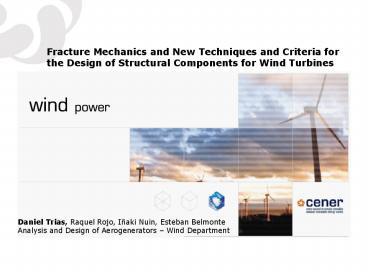Sin ttulo de diapositiva
1 / 27
Title: Sin ttulo de diapositiva
1
Fracture Mechanics and New Techniques and
Criteria for the Design of Structural Components
for Wind Turbines
Daniel Trias, Raquel Rojo, Iñaki Nuin, Esteban
Belmonte Analysis and Design of Aerogenerators
Wind Department
2
Index
- INTRODUCTION
- Failure of composites a matter of scale
- Failure criteria for fibre-reinforced composites
- FRACTURE MECHANICS FOR ADHESIVE/DELAMINATION
ASSESSEMENT VCCT - Stresses in a single lap joint (Illustrative
example) - VCCT Implementation in a commercial FE code
- Application example
- FRACTURE MECHANICS IN FAILURE CRITERIA LaRC
criteria - (Short) Description
- Application example (only on article)
3
INTRODUCTION
4
Failure in composites a matter of scale
Failure depends on phenomena (matrix and fibre
cracking, debonding, kinking ) which take place
at a scale of about 10um and which are
nearly-brittle
5
Failure in composites a matter of scale
5.000.000 1 scale relation with microscale
(fibre diametre)
46 m
2.29 m
Liberty
Yao Ming
Blade
6
Failure criteria for fibre reinforced composites
- MICROSCOPICAL CRITERIA
- Failure of single constituents fibre, matrix
- May be used in multi-scale analysis
- Computationally unaffordable for large structures
- MACROSCOPICAL CRITERIA
- Empirically obtained from global behaviour of
laminae - Generally symmetrical
- Black box
- Ply level or laminate level
- Tsai-Hill, Tsai-Wu, etc.
- PHENOMENOLOGICAL CRITERIA
- Bridge micro and macro behaviour by analyzing
specific phenomena - Ply level
- Hashin, Hashin-Roten, Puck, etc.
- Puck Analyzes fracture plane successfully spread
since WWFE - Puck Physically meaningless parameters
Refine some failure criteria Adhesive joints/
Delamination assessment - VCCT - Decohesive
elements
- FRACTURE MECHANICS
- Theory 1900s. Application in Computational
Mechanics 1970s - Introduce the effect of defects in brittle
behaviour, analyze kinking. - NASA LaRC Criteria. Physically based parameters
7
FRACTURE MECHANICS FOR ADHESIVE/DELAMINATION
ASSESSMENT VCCT
8
Adhesive failure may happen
9
Stresses in a single lap joint
Single lap joint
10
Stresses in a single lap joint
Single lap joint
LARGE stress gradients!
Shear stresses
(Induced) Peel stresses
11
Adhesive implementation in FE model stress-based
approach
Single slab joint (FE model)
2 nodes with same coordinates joined with a
MPC/rigid link
Adhesive
Elastic spring element
2 nodes with same coordinates joined with a
MPC/rigid link
12
Stress dependence on mesh size
13
Fracture Mechanics approach
- Based on crack propagation analysis
- Specially well-suited for cracked materials and
brittle behaviour - Provides concepts and tools which allow the
analysis of microscale phenomena and their
application to component-scale situations. - Energy based analysis stable solution for
stress singularities
14
Fracture Mechanics approach
- GIc, GIIc, GIIIc are material properties.
Usually - GIc lt GIIc lt GIIIc
- Critical values of G are needed for each mode.
Tests with a standard - Mode I DCB test (ASTM, DIN, ISO)
- Mode II ENF test (DIN)
- Mixed mode I/II MMB test (ASTM)
- Mode III some proposals
- Failure criteria (Loss of adhesion /
delamination) - GI gt GIc ?
- GII gt GIIc ?
- GIII gt GIIIc?
- We need to compute GI, GII, GIII numerically
Virtual Crack Closure Technique (VCCT) - Basic assumption the energy needed to open a
crack some ?a length is the same energy needed to
close it some ?a length
15
Fracture Mechanics approach VCCT
Debonded region
Bonded region
Crack tip
Adhesive
GgtGc? Would a potential crack propagate?
16
Crack tip Local coordinate system
Non-straight crack tip Local coordinate system
to be defined at each node of the crack tip
Crack tip
Bonded region
yL
Debonded region
xL
i
x
k
17
Implementation with a commercial FE code
Modification of adhesive model r.link ? spring
r.link
Model with defined adhesive zone (r.link)
Model with non-rigid adhesive zone
FE commercial software (Nastran, Marc)
FE SOLUTION
External code (MATLAB)
Stress solution
USER INTERACTION
Initiation criteria
Definition of critical zones to crack initiation
Computation of G (VCCT)
18
Application to a Turbine Blade (1)
19
Application to a Turbine Blade (2)
Initiation criteria (stress) ? Detect zones where
crack may appear
20
Application to a Turbine Blade (2)
Crack creation Adhesive is removed from those
nodes showing larger value of the stress-based
criteria
Need to solve again!
21
Application to a Turbine Blade (3)
GI, GII, GIII computed through VCCT formula,
considering crack local coordinate system
Check adhesive failure criteria based on energy
release rate
Nearly the same methodology may be used for
delamination
22
FRACTURE MECHANICS IN FAILURE CRITERIA LaRC
criteria
23
Improvements achieved with LaRC
- Fracture Mechanics employed for tensile matrix
failure. In situ effects (dependence on ply
thickness) are considered - Fibre kinking computed through Fracture
Mechanics
- Drawbacks
- Iteration required for the computation of
fracture plane angles - Not (yet) spread in industry
24
Application to a component
s11gt0 and s22gt0
25
Application to a component
s11lt0 and s22lt0
26
Final Remarks and conclusions
- Fracture Mechanics can be used successfully even
in commercial finite element codes for adhesive
assessment. - VCCT can be used for both adhesive and
delamination assessment. - Fracture Mechanics has been used (NASA) to
improve some failure criteria - Biaxial Compression
- Fibre Kinking
- Future work
- Compare with models with analytical solution
(almost done!) - Compare with tests on a substructure
- Fatigue model
27































